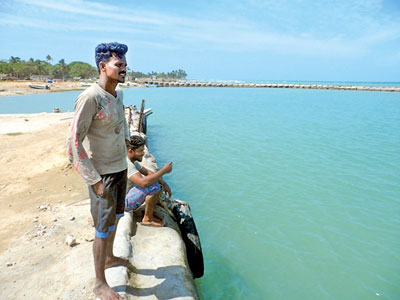Northern Myliddy, once second largest fish producer, slowly returns to normal
Myliddy in Sri Lanka’s northern Jaffna region, which once had the country’s second largest habour until the raging ethnic conflict destroyed that, is slowly returning to normal.

Fishing at Myliddy
For 27 years, the area was controlled by the army until last July when the Myliddy jetty was released to the public bringing happiness to the people. But living conditions in the area had deteriorated because all the houses were damaged during the war.
Kankesanturai buses have extended their services up to Myliddy, but the Myliddy-Point Pedro road is still closed. Myliddy villagers who suffered most have settled in Point Pedro. Two tea shops and three small groceries shops have opened in addition to six hardware shops, the reason is demand for building materials in the area.
Before fighting erupted in the north in the mid-1980s, 40 per cent of the fish production in Sri Lanka came from Myliddy, Fisheries Minister Mahinda Amaravera stated in Parliament recently.
On average, sixteen lorries of fish were sent to the main Colombo fish market daily before 1983.
K. Gunabalasingham, Myliddy resettlement committee Chairman said three ice plants also functioned in Myliddy and if their ice bar production was not enough for the fish lorries, fish traders purchased ice bars from then Elephant House, Colombo.
When in 1990, people became displaced from the areas this included 300 fishermen families who lived in the Myliddy jetty and 1100 fishermen families who lived in the village.
S, Ram, a returnee resident, said the Government grant for the housing scheme is only Rs. 790,000 and that is not enough to build a new house. “I spent another Rs. 800,000 and built a house in my own land, it is 60 per cent completed now.”
At the Myliddy jetty, three boys who were fishing said only 20 families have resettled in the jetty area. Others visit during the daytime to supervise renovation work on their land and return to their temporary residences in the evening.


